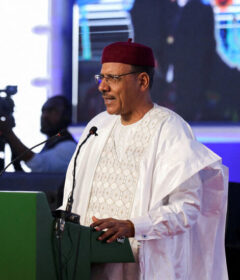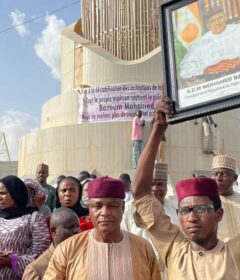Fighting Ebola When Mourners Fight the Responders
BENI, Democratic Republic of Congo — When Ebola came to this city in the Democratic Republic of Congo, Janvier Muhindo Mandefu quit farming and got work burying the highly contagious bodies of Ebola victims.
But Mr. Muhindo is less afraid of Ebola than of the mourners he encounters at funerals. He and his burial team have been attacked by relatives of the dead, one swinging a hoe. Mourners have shouted at team members, accusing them of stealing the organs of corpses, and have threatened to throw them into the open graves. Last month a mourner brandished a hand grenade, he said, sending everyone scattering and leaving a 3-year-old Ebola victim unburied.
“Someone like me can be buried alive,” Mr. Muhindo said as his colleagues hosed down their trucks at the Red Cross compound after another day of burials.
This Ebola outbreak in eastern Congo, the second-largest ever recorded, is now spiraling out of control. Despite some early success — helped by a new and effective vaccine — the disease has come roaring back in the past two months.
Efforts to combat the epidemic have been hobbled by attacks on treatment centers and health workers; deep suspicion of the national government, which is managing the eradication efforts; and growing mistrust of the international medical experts who have struggled to steer patients into the treatment centers, according to interviews with dozens of family members, politicians, doctors and health workers in recent weeks.
When a doctor was killed, and treatment centers attacked by gunmen or set on fire, front-line health workers suspended their work, giving the virus time to spread. Some medical and aid groups have decided to pull some of their personnel from the very areas where Ebola has hit hardest.
So far nearly 1,150 people have died in the outbreak, according to the World Health Organization. But that is a significant undercount, aid groups said in interviews. Health workers have been turned away regularly from homes where someone has died, leaving them unable to test for Ebola.
Earlier in the outbreak, the police would remove these bodies from homes, at gunpoint if necessary, said Philemon Kalondero, 39, who is often the first member of his Ebola response team to arrive at a grief-stricken home.
“The new protocol is that we just abandon the body,” he said. “They will learn their lesson when they get sick.”
Initial Optimism
When the outbreak was discovered last summer, health workers had reason to worry. This part of eastern Congo has long been beset by dozens of armed groups fighting over land, natural resources, ethnicity and religion — including one outfit with ties to the Islamic State.
Yet optimism ran strong among the arriving wave of international health experts and humanitarian workers, many of whom had experience treating Ebola, an often fatal disease caused by a virus that is transmitted by body fluids.
They came with lessons learned from the outbreak that tore across West Africa starting in 2013, killing more than 11,000 people. And they were buoyed by a recent success: the speedy containment of an outbreak in western Congo.
They also brought medical advances: a strikingly effective vaccine, experimental treatments, and a transparent container known as the “cube” that Ebola patients live inside, reducing the transmission risk to doctors and visitors.
Some of the responders hoped that big outbreaks were already a thing of the past.
The stakes were high. The outbreak was in one of Congo’s most populous regions, and near the borders of three countries — Rwanda, Uganda and South Sudan — raising fears that it would spread beyond Congo.
And while Congo has had nine earlier recorded Ebola outbreaks, the disease had never been detected in the region until it showed up last year in a town called Mangina, health workers said.
By late summer it had traveled down a dirt road to Beni, a city of about 350,000 that was reeling from a series of massacres by machete that killed an estimated 800 people in recent years. The assailants’ identity and motive were difficult to determine, but a research group concluded that in addition to rebels, the Congolese Army had a role — leaving many residents unsure whom to trust.
They saw Ebola as the latest in a spate of unexplained but connected disasters.
Some local politicians publicly suggested that the national government — or some other hidden hand — had imported the disease. Conspiracies took root. In this fiercely independent region, only 2 percent of those recently surveyed said they trusted the national government in Kinshasa, 1,000 miles away.
“Scientifically, I don’t believe that it’s possible to first have the killings of people in Beni, and now this disease without them being related,” said Crispin Mbindule Mitondo, a member of the national assembly, in remarks broadcast on local radio and circulated on WhatsApp.
The Politics of Ebola
Ebola landed right ahead of a tight national election that was shaping up to be the first transfer of power by ballot in Congo since independence in 1960. But Kinshasa suspended voting in Ebola-affected areas in December, citing the risk that polling places might spread the disease.
This area was also an opposition stronghold. So for many, the announcement confirmed their suspicions that Ebola was part of a plot, managed by Kinshasa, to deny them their vote.
A day after the announcement canceling the vote, protesters stormed an Ebola triage center in Beni and set it on fire.
“When they canceled the elections, it was a disaster for us,” said Emmanuel Massart, an emergency coordinator for Doctors Without Borders, which has run several Ebola treatment centers in Congo.
Adding to the suspicion, vaccination teams and other responders often traveled under armed police or military escort. This made it appear that the Ebola response, which relied heavily on international medical organizations and the United Nations, was an extension of an unpopular national government.
Making matters worse, police officers and soldiers accompanying Ebola response teams have on occasion opened fire during confrontations with grieving family members and neighbors, according to interviews with health workers who described three such episodes — one that is being examined by the United Nations. The confrontations tend to occur when Ebola responders try to take bodies away from grieving family members and take charge of the burial.
As the disease spread to Butembo, a larger, more prosperous city of about one million, many patients who had Ebola resisted going to designated treatment centers, seeing them as a place to die rather than be cured.
Other patients who went to see their doctors with common symptoms, such as headaches and fevers, were often forced into Ebola quarantine centers for a few days pending tests.
Many of the symptoms of Ebola resemble those of more common maladies, such as malaria. At one quarantine facility in Beni, fewer than 2 percent of patients tested positive for Ebola, according to interviews with health officials and an epidemiological report provided by a medical organization.
Mistrust settled in, affecting even those who have seen Ebola up close.
“The way my wife died, it is not Ebola that killed her that day,” said Héritier Bedico Zawadi, an engineer, one sleepless month after the death of his wife, Suzanne Kahindo Kitseghe, a 29-year-old doctor.
She had been exposed to the disease when a patient at her hospital wouldn’t stop bleeding, a classic Ebola symptom, after an IV line had been inserted, according to Dr. Michel Kalongo, an official in the local doctors union who knew Dr. Kahindo.
Dr. Kahindo had not been vaccinated, probably because she was pregnant and pregnant women were initially discouraged from receiving the vaccine. When she began to feel ill, she believed she had malaria and continued to see patients, even helping deliver a patient’s baby.
An alarmingly high percentage of transmissions occur in hospitals and clinics — as high as 40 percent recently around Mandima, although in most places it is far lower, according to an analysis of cases that was shared among medical and aid groups.
Dr. Kahindo was barely conscious on April 10 when colleagues sent her to an Ebola treatment center, where she died the next day. Her husband said that when other doctors expressed condolences, they often said, “Your wife didn’t die of Ebola.”
Gazing up at the night sky, Mr. Zawadi said that even though his wife had tested positive for Ebola, he was having trouble making up his mind about what to believe. “Emotionally, I’m broken.”
In February, an Ebola treatment center — this time in Katwa, an outlying area of Butembo and run by Doctors Without Borders — was also set on fire. A printed warning was left at the site, according to Rachel Sweet, a postdoctoral fellow at Harvard who studies eastern Congo. It said, “After this, we will plan even bigger things in the near future.”
Many of the patients fled into the night. Some of those too sick to flee were transferred to a nearby treatment center — which was in turn attacked.
In the days that followed, the Ebola response ground to a standstill in the epicenter of the outbreak. Doctors Without Borders pulled out of the city. When work resumed, the numbers of those infected began to rise — a pattern that would repeat.
In April, a Cameroonian doctor working on the Ebola response with the World Health Organization was shot to death by intruders while leading a meeting at a university hospital in Butembo.
Who is behind these attacks? Many health workers and foreign medical organizations say they do not fully understand the forces aligned against them. But they are all aware that resentment has been stirred up by the sight of late-model S.U.V.s carrying foreigners and Kinshasa bureaucrats through town, offering high-paying jobs to some but not others.
“The Ebola response has a lot of money, and this amount of money is kind of shifting power around, challenging the equilibrium,” said Mr. Massart of Doctors Without Borders. “I think that is one motivation” for the hostility to Ebola responders.
The outbreak remains confined to a single region, largely thanks to an effective vaccine, doctors say. More than 110,000 people have been vaccinated, including front-line responders such as doctors and burial teams, which has slowed the spread.
The treatment centers have saved people, such as Daniella, a baby who arrived at a treatment center with Ebola when she was 12 days old. A month later, she was deemed cured, according to the Congolese health department.
“Can we stop the epidemic? Certainly we can,” said Mike Ryan, who runs the World Health Organization’s emergencies program. But to do so, he said, a political solution that reduced the violence was first needed.
For now, many of the front-line Ebola workers say they keep their work a secret from neighbors. Perhaps no job is riskier than that of the burial teams, who retrieve the bodies of people suspected of dying from Ebola from grieving families.
Mr. Muhindo, the burial team leader in Beni, recounted the funeral last month of the 3-year-old boy who had died of Ebola. The boy’s father, a soldier, stood in stunned grief. But other mourners crowded the coffin, demanding that the boy’s body be inspected for signs of organ theft. Mr. Muhindo, who has received the Ebola vaccine, said he unzipped the bag to the boy’s sternum.
“They said, ‘Open it up all the way so we can see the entire body,’” Mr. Muhindo recalled.
People shouted that he would be buried next. As he tried to slip away, someone — perhaps another soldier — brandished a grenade and threatened to blow up the team.
Mr. Muhindo said that he and his team fled. As he looked back, he could see the boy’s father rush over and take the grenade from the man.
Finbarr O’Reilly contributed reporting from Beni, Democratic Republic of Congo.
Joseph Goldstein writes about policing and the criminal justice system. He has been a reporter at The Times since 2011, and is based in New York. He also worked for a year in the Kabul bureau, reporting on Afghanistan. @JoeKGoldstein
Source: Read Full Article






